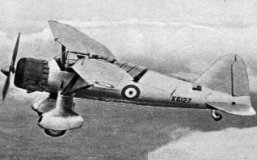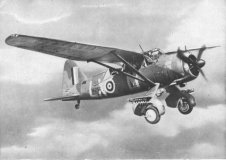
Westland Lysander
When Westland created its most famous aircraft, the immortal Lysander, in 1935, no one dreamed that this high-winged craft would fly into occupied territory, at night, on secret missions vital to the outcome of World War II. The Lysander introduced STOL (short take-off and landing) capability, crucial to today's military, long before the term was coined. As a flagship for spying missions behind the lines, it had no equal.
The Westland Lysander entered service in 1938 and served throughout the war. A versatile, solid performer useful for a wide range of duties, the aircraft earned a special place in history for its ability to land in unbelievably short spaces and drop off or retrieve secret agents working far behind enemy lines. The Lysander's broad wing and huge flight surfaces enabled it to land in unpaved fields, often with as little as 200 m (650 ft) of taxi space. This was a treacherous job for its pilot - in many ways, riskier than the more glamorous task of flying fighters but these covert missions were of paramount importance.
The Lysander is best-remembered for its use by confidential agents of British Intelligence and of the American Office of Strategic Services but it also carried out many other tasks. Although less than ideal as an observation craft, the Lysander carried out reconnaissance missions and served as a spotter for Allied warplanes and artillery. Some aircraft functioned as VIP transports at battlefields where paved runways were unavailable. The Lysander made a unique contribution to World War II.
|

|
 |
 |
 |
| With a wide range of speed, short-field take-off and landing capability and a strong undercarriage, the Lysander was well suited to clandestine flights into the fields of Belgium, France and Holland. |
This Lysander wears the markings of the Finnish air force early in 1940. Nine aircraft were obtained for Army co-operation duties being fitted with removable stub winglets/bomb racks on each undercarriage leg for up to six 9 kgs high explosive bombs. |
RAF Lysander Mk IIIAs completed over 400 special operations between August 1941 and December 1944. They supplied the Resistance and flew agents in and out. |
|
Westland Lysander (Technical Specification) |
| Role |
Army co-operation aircraft |
| Manufacturer |
Westland |
| Maximum Speed |
341 kmh (211 mph) |
| Maximum Range |
966 km (600 miles) |
| Ceiling |
6655 meters (21,800 feet) |
Weight
Empty
Maximum Takeoff |
1,980 kg (4,356 lbs)
2,866 kg (6,305 lbs) |
Dimensions
Wingspan
Length
Height
Wing Area |
15.24 meters (50 ft)
9.30 meters (30 ft 6 in)
4.42 meters (14 ft 6 in)
24.15 square meters (260 sq ft) |
| Engines |
One Bristol Mercury XX radial piston engine which provides 649-kW (870-hp) |
| Armament |
Four 7.7 mm (0.303 cal) Browning machine-guns (one in each wheel spat and two on trainable mount in rear cockpit)
227 kgs (500 lbs) of flares, rocket projectiles or bombs |
Photo Gallery
Click here to submit your photo
| Have A Passion For Aircraft? |
Subscribe to our 14 series FREE newsletter
delivered weekly on World War 2 Aircraft factfile... |
| NB:- We hate spam as much as you do, so your email address will NEVER be shared with or sold to anyone else. That's a Guarantee. |
|
|





